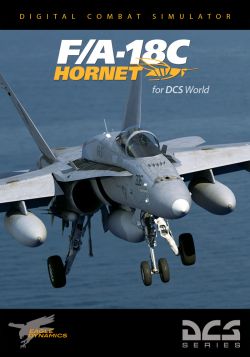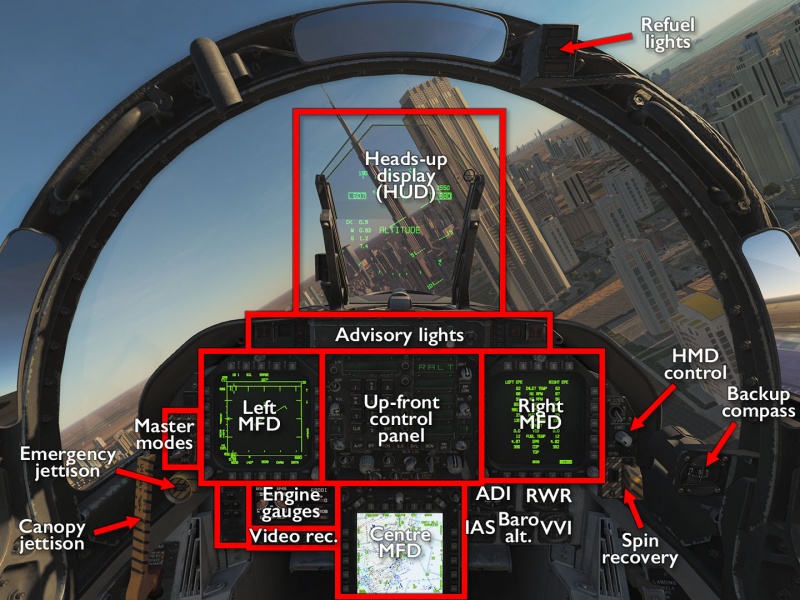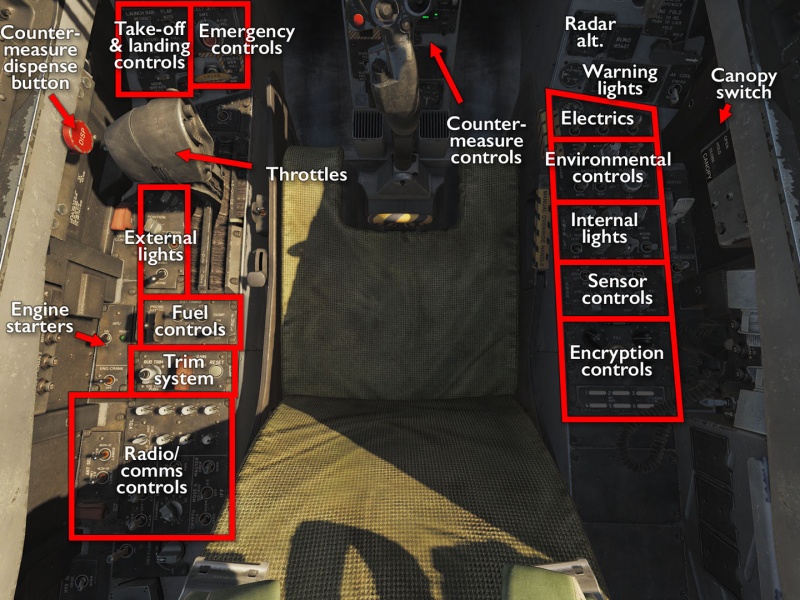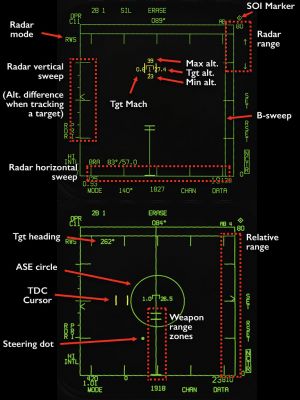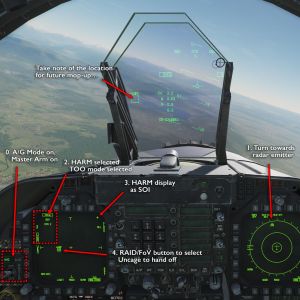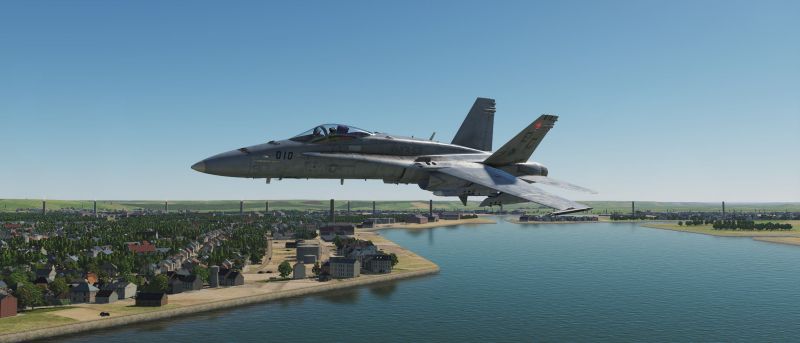FA-18C Hornet: Difference between revisions
m (→�) |
mNo edit summary |
||
| (23 intermediate revisions by 2 users not shown) | |||
| Line 1: | Line 1: | ||
{{DISPLAYTITLE:F/A-18C Hornet}} | {{DISPLAYTITLE:F/A-18C Hornet}} | ||
{{beta}} | {{beta}} | ||
{{RightImg| | {{RightImg|File:DCS-F-18C_700x1000_v2.jpg}} | ||
[[File:FA-18C_icon.png|frameless|left]] | [[File:FA-18C_icon.png|frameless|left]] | ||
| Line 17: | Line 17: | ||
* Tons of air-to-air missiles, including off-boresight, helmet-cued AIM-9X as well as AMRAAMS to always be able to shoot when the enemy cannot. | * Tons of air-to-air missiles, including off-boresight, helmet-cued AIM-9X as well as AMRAAMS to always be able to shoot when the enemy cannot. | ||
* AGM-88 HARM missiles for SAM hunting. | * AGM-88 HARM missiles for SAM hunting. | ||
* AGM-84 Harpoon missiles for fishing trips. | |||
* Laser-guided bombs and Mavericks, as well as the regular set of unguided bombs and IR Mavericks. | * Laser-guided bombs and Mavericks, as well as the regular set of unguided bombs and IR Mavericks. | ||
* An extensive moving-map navigation suite that lets you fly via GPS, [[TACAN]], NDBs, and a carrier-specific ILS system (that does not help you with regular airports). | * An extensive moving-map navigation suite that lets you fly via GPS, [[TACAN]], NDBs, and a carrier-specific ILS system (that does not help you with regular airports). | ||
* Programmable automated and manual [[Radar_Warning_Receiver|RWR]] and countermeasure management, troubled by a constant debate on whether it should use an old inverted display (more dangerous targets farther out the threat ring) or not. | * Programmable automated and manual [[Radar_Warning_Receiver|RWR]] and countermeasure management, troubled by a constant debate on whether it should use an old inverted display (more dangerous targets farther out the threat ring) or not. | ||
* An actual, reasonably working ground radar. | |||
Comes with the built-in campaigns [[Built-in_Campaigns#Hornet_1989_-_Task_Force_Challenger|Hornet 1989 - Task Force Challenger]]. | Comes with the built-in campaigns [[Built-in_Campaigns#Hornet_1989_-_Task_Force_Challenger|Hornet 1989 - Task Force Challenger]]. | ||
== Flying the F/A-18C == | == Flying the F/A-18C == | ||
| Line 58: | Line 49: | ||
* Carefully start removing the brakes so you can get into position. | * Carefully start removing the brakes so you can get into position. | ||
* Line up, extend the launch bar, hook up (default bind {{Key|U}}), and run up the engines. | * Line up, extend the launch bar, hook up (default bind {{Key|U}}), and run up the engines. | ||
* Kick in the afterburners (this may require manipulation of the finger lift levers depending on your settings) and ''keep your hands off the stick'' as the catapult and (hopefully accurate) trim setting | * Kick in the afterburners (this may require manipulation of the finger lift levers depending on your settings) and ''keep your hands off the stick'' as the catapult and (hopefully accurate) trim and flaps setting get you in the air and climbing. | ||
=== Shooting something === | === Shooting something === | ||
Two stand-out features built the early anticipation of the F/A-18C module: the full-sim implementations of the AMRAAM and HARM missiles. The AMRAAM was previously only available on the [[Flaming_Cliffs_3|FC3]]-level [[F-15C_Eagle|F-15C]], and the only proper SEAD weapon were the Kh-25 and Kh-58 anti-radiation missiles on the [[Su-25T_Frogfoot|Su-25T]] — also a simplified FC3 aircraft. Finally, you could get frustrated by poor missile logic in '''full fidelity'''! | |||
==== BVR engagement ==== | ==== BVR engagement ==== | ||
[[File:FA-18 Radar.jpg|thumb|RWS Radar elements]] | [[File:FA-18 Radar.jpg|thumb|RWS Radar elements]] | ||
Ideally, the AMRAAM should be fired from a Track-While-Scan mode using datalinking to fly towards a target without it being noticed, and switching to active mode (go “pitbull”) when it's already too late. With TWS finally fully implemented, its ability to passively track the locations of multiple targets and tell a whole wing-full of AMRAAMs where to is definitely an option, but is also a bit more complicated and confusing than simply locking up a target and sic missiles at it. | |||
The AMRAAM is often thought of as an active-homing missile, but that is (quite literally) just half the story. It only goes active within 8–10nm from the target, and needs to be supported from the aircraft up until that point. In terms of actual engagement range, it is in practice not ''that'' much more capable than the AIM-7 Sparrow — at least not the later MH models with more advanced flight logic &mash; but being able to turn to a more effective intercept course as you dive into the merge does make a difference. Is is particularly true when you carry the AIM-9X and can fire off-boresight from very odd angles. | |||
Aside from the actual weapon selection, and being able to turn away sooner, the procedure for firing the AIM-120 is thus not that different from firing the AIM-7: | |||
* Make sure the radar is on (because… well, ''radar''-guided missiles). | |||
* Turn on AA mode and Master arm on the left front dashboard. | |||
* Switch to the Fire Control Radar (FCR) display on one MFD if it is not showing already, and check the upper left corner (corresponding to MFD button 20) for the radar mode. | |||
* Set radar range and elevation to match where the target should be according to AWACS (or friends in general).<br><small>'''Note:''' The Target Designator Cursor (TDC) on the FRC display will show two numbers above and below the TDC: the max and min scanning altitude at the range of the cursor. If the target is outside of this altitude band, the radar will not pick it up even if the horizontal/BRA position is correct.</small> | |||
* Slewing the TDC over any of the green radar returns will provide more information about the target, such as its altitude and mach number. | |||
* Press TDC Down (default key {{Key|Enter}}) to lock up the target and enter STT mode.<br><small>'''Note:''' in STT, the radar will adjust azimuth and elevation automatically to track the target. As such the controls and displays for these inputs will be disabled.</small> | |||
* Both FCR and HUD will show a steering dot and a Allowable Steering Error (ASE) circle. Manoeuvring to keep the dot in the circle will allow for a proper intercept while still maintaining a lock on the target. | |||
* The FCR will display a pole extending from the bottom showing the effective range of the missile based on current relative speeds and altitudes. Keep approaching unit the target is ''at least'' inside the second of the max-range bars.<br><small>'''Note:''' the absolute max range is only achievable if the target does not manoeuvre in any way whatsoever. Firing at this range may be useful to force the target to go defensive, but is all likelihood, it will not actually hit.</small> | |||
* When inside practical range, a SHOOT cue will appear on the HUD and FCR. Do what the cue says. | |||
==== Using the HARM ==== | ==== Using the HARM ==== | ||
[[File:FA-18 HARM.jpg|thumb|HARM TOO engagement]] | [[File:FA-18 HARM.jpg|thumb|HARM TOO engagement]] | ||
The AGM-88C High Speed Anti-Radiation Missile is a very simple missile to use, but it can be used simply in many complicated ways. Its effective range will vary greatly with the launch altitude, but even within fairly reasonable parameters it can outrange any SAM currently available in DCS. The problem is, of course, that the SAM systems where you want to use that long range are also the ones where you do not want to be at high altitude, and the ones that can fairly trivially defend themselves against long-range missile shots… | |||
Currently, the HARM has two modes: Self-Protect (SP) and Target of Opportunity (TOO). Self-protect is intended for exactly that: you fire off the missile pre-emptively as you close in on a target, at which point it lofts to a high altitude and starts looking for any active emitters. If something lights up to lock you on, the missile comes down on it, to ''protect'' you as it it were. SP is so simple as to not even warrant a lengthy description — just select, fire, go make some tea, hope for some sudden help from above if nasty things start to happen. | |||
TOO is a more direct targeting mode: looking through the missile seeker, you pick a specific emission source and tell the missile to go after it. To employ the HARM in TOO mode: | |||
* Make sure the RWR is on so you have any idea something is targeting you. For good measure, also have the EW MFD page up. | |||
* Turn on AG mode and Master Arm on the left front dashboard. | |||
* Select the HARM from Stores page (or indeed almost any page, since it populates the top of most pages in AG mode). | |||
* Select TOO mode and make the HARM display SOI by pushing left or right on the Sensor Control Switch on the stick. | |||
* Fly towards an offending emitter — the HARM display shows the (rather narrow) PoV of the missile seeker, and you need to point it in the right direction to be able to target anything.<br><small>'''Note:''' an emitter that is detected but outside the HARM's field of view will show up as an arrow in the HARM page pointing towards the emitter, letting you know where to turn.</small> | |||
* Once the radar is in view, press the RAID/FLIR FoV button on the throttle to select it (and/or to flip through available emitters if there are multiple to choose from). | |||
* Press the Uncage button on the throttle to hand off the target to the missile. | |||
* When hand-off is complete, pickle, and turn away. | |||
[[File:FA-18C Over LeHavre.jpg|800px|frameless|F/A-18C over Le Havre]] | [[File:FA-18C Over LeHavre.jpg|800px|frameless|F/A-18C over Le Havre]] | ||
| Line 73: | Line 93: | ||
* [https://www.mudspike.com/chucks-guides-dcs-f-a-18c-hornet/ Chuck's F/A-18C Hornet guide] at Mudspike. | * [https://www.mudspike.com/chucks-guides-dcs-f-a-18c-hornet/ Chuck's F/A-18C Hornet guide] at Mudspike. | ||
* [https://www.digitalcombatsimulator.com/en/shop/modules/hornet/ DCS: F/A-18C Hornet] in the DCS shop. | * [https://www.digitalcombatsimulator.com/en/shop/modules/hornet/ DCS: F/A-18C Hornet] in the DCS shop. | ||
=== Related DCS modules === | |||
* [[Supercarrier|DCS: Supercarrier]] | |||
* F/A-18C ''Aggressors BFM'' Campaign by Maple Flag Missions | |||
* DCS: F/A-18C Hornet - ''The Serpent's Head 2'' Campaign by Badger 633 | |||
* DCS: F/A-18C ''Operation Pontus'' Campaign by 373vFS_Greg, 373vFS_Petritis, Baltic Dragon | |||
* DCS: F/A-18C ''Raven One'' Сampaign by Baltic Dragon | |||
* DCS: F/A-18C ''Rising Squall'' Campaign by Inverted | |||
== More information == | == More information == | ||
<youtube>https://www.youtube.com/watch?v=EV4fNIyogec</youtube> | |||
<youtube>https://www.youtube.com/watch?v=EV4fNIyogec | |||
* [https://en.wikipedia.org/wiki/McDonnell_Douglas_F/A-18_Hornet McDonnell Douglas F/A-18 Hornet] on wikpedia. | * [https://en.wikipedia.org/wiki/McDonnell_Douglas_F/A-18_Hornet McDonnell Douglas F/A-18 Hornet] on wikpedia. | ||
* [https://www.globalsecurity.org/military/systems/aircraft/f-18.htm F/A-18 Hornet] on globalsecurity.org | * [https://www.globalsecurity.org/military/systems/aircraft/f-18.htm F/A-18 Hornet] on globalsecurity.org | ||
* [https://www.youtube.com/watch?v=caZCncH6xqM&t=0s&index=2&list=PLer9oF4AanvFOfG4sSZSHJQZeMQx7YGr6 Matt Wagner's Hornet Training Videos] series. | * [https://www.youtube.com/watch?v=caZCncH6xqM&t=0s&index=2&list=PLer9oF4AanvFOfG4sSZSHJQZeMQx7YGr6 Matt Wagner's Hornet Training Videos] series. | ||
* BurntCornMuffin's guide to the [[FA-18C_Hornet/FPAS|Flight Performance Advisory System]] | |||
{{Aircraft}} | {{Aircraft}} | ||
[[Category:Full-sim_Aircraft]][[Category:Jet_Aircraft]][[Category:Aircraft]][[Category:Modules]][[Category:Beta_Modules]] | [[Category:Full-sim_Aircraft]][[Category:Jet_Aircraft]][[Category:Aircraft]][[Category:Modules]][[Category:Beta_Modules]] | ||
Latest revision as of 13:58, 14 April 2021
| This is a beta module.
This module is still being developed and may still be missing some features and equipment options. It is playable and most of the content is there, but some final touches and fixes for minor bugs are still in the works. It is probably safe to buy unless you crave absolute fidelity and/or very few bugs. |
The F/A-18C is slated to be one of, if not the most in-depth and complex module in the DCS stable, alongside the A-10C. It is still a work in (some would argue very slow) progress, which is perhaps understandable since the Hornet is a multi-role aircraft with the added complication that it is also carrier-based. It may not carry as many individually different weapons as the A-10C, but it already covers a much wider range of weapon types, and more are yet to come.
Overall, the Hornet is easy to fly and intuitive to use, and many systems will be familiar to, or even exact copies of, what you would find in the A-10C, AV-8B or even (in a much simplified form) in the F-15C. As such, it is not difficult to learn — there is just a lot to learn. If you have mastered the F-16C in BMS, getting to grips with it will be a cakewalk.
Features
Since it is a multirole aircraft, the feature list of the F/A-18C can easily become very long. The highlights include:
- All the hair-ripping, teeth-gnashing, fun and excitement of both carrier take-offs and landings, and air refuelling.
- More MFDs and glass cockpit features than is strictly necessary.
- Less than necessary engine thrust to compensate for all the MFDs.
- Tons of air-to-air missiles, including off-boresight, helmet-cued AIM-9X as well as AMRAAMS to always be able to shoot when the enemy cannot.
- AGM-88 HARM missiles for SAM hunting.
- AGM-84 Harpoon missiles for fishing trips.
- Laser-guided bombs and Mavericks, as well as the regular set of unguided bombs and IR Mavericks.
- An extensive moving-map navigation suite that lets you fly via GPS, TACAN, NDBs, and a carrier-specific ILS system (that does not help you with regular airports).
- Programmable automated and manual RWR and countermeasure management, troubled by a constant debate on whether it should use an old inverted display (more dangerous targets farther out the threat ring) or not.
- An actual, reasonably working ground radar.
Comes with the built-in campaigns Hornet 1989 - Task Force Challenger.
Flying the F/A-18C
Flying the Hornet is an interesting experience. On the one hand, it is a modern agile fly-by-wire aircraft that will keep up with or out-manoeuvre anything else in the sky, but on the other hand, it is actually comparatively slow and sluggish. It is not like the A-10C or Su-25, where hills are life-threatening obstacles, and altitude is something you can only dream of, but it is also not a speed demon that stands a chance to keep up with the likes of the M2000C or F-14.
The airframe traces its historical roots to the F-5, and this shows. It's a joy to fly, but you need to be aware of the slow throttle response and that the top speed is enough to get you there, but it will not exactly break any records.
Cockpit overview
Getting into the air
In keeping with the goal of making the F/A-18C module parallel the A-10C in terms of being a full-on study sim, at least as far as on-board systems go, getting the Hornet up and running is an involved process. As always the RWinHome “cheat” key combo is available to automate the start-up process, but it takes a while and the auto-start (and even the mission-editor hot start option) still leaves some systems for the pilot to start manually — most notably the RWR and countermeasure system.
It is not quite as long a process as in the A-10C, mainly thanks to the fact that there are fewer systems to set up and that the INS can leech off of the carrier to get its initial position data. At the same time, that slightly simpler system setup is counter-balance by the extra steps and the care needed to operate from a carrier. You do not want to have the engine roar to life while brake pressure is too low to keep the plane stationary, and you probably do not want to forget such tiny details as folding down the wings and hooking up to the catapult correctly. Taking an ignominious low-speed dive off the ramp, falling 15 meters into the water, exploding and then getting minced by propellers is not a good way to start the day.
The manual and Chuck's guide linked below give a full account of the procedure, but the broad strokes are:
- Making sure every type of brakes are on — chocks, parking brake, regular brakes, everything!
- Turning power on, warning your surroundings, and checking for errors.
(Battery, APU, lights, brake test, APU check.) - Turning engines on, starting with the right one.
(Right engine crank, right throttle to idle, monitor the spool up.) - Turning on most of the avoinics.
(GPWS, MFDs, HUD, radar altimeter, bleed air, FCS.) - Star aligning the INS — this will take a while.
- Turning the left engine on.
- Turning the remaining systems on and setting them up.
(Oxygen, hook, flaps, anti-skid, radar, trim, wings, ADI, RWR, etc etc etc.) - Carefully start removing the brakes so you can get into position.
- Line up, extend the launch bar, hook up (default bind U), and run up the engines.
- Kick in the afterburners (this may require manipulation of the finger lift levers depending on your settings) and keep your hands off the stick as the catapult and (hopefully accurate) trim and flaps setting get you in the air and climbing.
Shooting something
Two stand-out features built the early anticipation of the F/A-18C module: the full-sim implementations of the AMRAAM and HARM missiles. The AMRAAM was previously only available on the FC3-level F-15C, and the only proper SEAD weapon were the Kh-25 and Kh-58 anti-radiation missiles on the Su-25T — also a simplified FC3 aircraft. Finally, you could get frustrated by poor missile logic in full fidelity!
BVR engagement
Ideally, the AMRAAM should be fired from a Track-While-Scan mode using datalinking to fly towards a target without it being noticed, and switching to active mode (go “pitbull”) when it's already too late. With TWS finally fully implemented, its ability to passively track the locations of multiple targets and tell a whole wing-full of AMRAAMs where to is definitely an option, but is also a bit more complicated and confusing than simply locking up a target and sic missiles at it.
The AMRAAM is often thought of as an active-homing missile, but that is (quite literally) just half the story. It only goes active within 8–10nm from the target, and needs to be supported from the aircraft up until that point. In terms of actual engagement range, it is in practice not that much more capable than the AIM-7 Sparrow — at least not the later MH models with more advanced flight logic &mash; but being able to turn to a more effective intercept course as you dive into the merge does make a difference. Is is particularly true when you carry the AIM-9X and can fire off-boresight from very odd angles.
Aside from the actual weapon selection, and being able to turn away sooner, the procedure for firing the AIM-120 is thus not that different from firing the AIM-7:
- Make sure the radar is on (because… well, radar-guided missiles).
- Turn on AA mode and Master arm on the left front dashboard.
- Switch to the Fire Control Radar (FCR) display on one MFD if it is not showing already, and check the upper left corner (corresponding to MFD button 20) for the radar mode.
- Set radar range and elevation to match where the target should be according to AWACS (or friends in general).
Note: The Target Designator Cursor (TDC) on the FRC display will show two numbers above and below the TDC: the max and min scanning altitude at the range of the cursor. If the target is outside of this altitude band, the radar will not pick it up even if the horizontal/BRA position is correct. - Slewing the TDC over any of the green radar returns will provide more information about the target, such as its altitude and mach number.
- Press TDC Down (default key Enter) to lock up the target and enter STT mode.
Note: in STT, the radar will adjust azimuth and elevation automatically to track the target. As such the controls and displays for these inputs will be disabled. - Both FCR and HUD will show a steering dot and a Allowable Steering Error (ASE) circle. Manoeuvring to keep the dot in the circle will allow for a proper intercept while still maintaining a lock on the target.
- The FCR will display a pole extending from the bottom showing the effective range of the missile based on current relative speeds and altitudes. Keep approaching unit the target is at least inside the second of the max-range bars.
Note: the absolute max range is only achievable if the target does not manoeuvre in any way whatsoever. Firing at this range may be useful to force the target to go defensive, but is all likelihood, it will not actually hit. - When inside practical range, a SHOOT cue will appear on the HUD and FCR. Do what the cue says.
Using the HARM
The AGM-88C High Speed Anti-Radiation Missile is a very simple missile to use, but it can be used simply in many complicated ways. Its effective range will vary greatly with the launch altitude, but even within fairly reasonable parameters it can outrange any SAM currently available in DCS. The problem is, of course, that the SAM systems where you want to use that long range are also the ones where you do not want to be at high altitude, and the ones that can fairly trivially defend themselves against long-range missile shots…
Currently, the HARM has two modes: Self-Protect (SP) and Target of Opportunity (TOO). Self-protect is intended for exactly that: you fire off the missile pre-emptively as you close in on a target, at which point it lofts to a high altitude and starts looking for any active emitters. If something lights up to lock you on, the missile comes down on it, to protect you as it it were. SP is so simple as to not even warrant a lengthy description — just select, fire, go make some tea, hope for some sudden help from above if nasty things start to happen.
TOO is a more direct targeting mode: looking through the missile seeker, you pick a specific emission source and tell the missile to go after it. To employ the HARM in TOO mode:
- Make sure the RWR is on so you have any idea something is targeting you. For good measure, also have the EW MFD page up.
- Turn on AG mode and Master Arm on the left front dashboard.
- Select the HARM from Stores page (or indeed almost any page, since it populates the top of most pages in AG mode).
- Select TOO mode and make the HARM display SOI by pushing left or right on the Sensor Control Switch on the stick.
- Fly towards an offending emitter — the HARM display shows the (rather narrow) PoV of the missile seeker, and you need to point it in the right direction to be able to target anything.
Note: an emitter that is detected but outside the HARM's field of view will show up as an arrow in the HARM page pointing towards the emitter, letting you know where to turn. - Once the radar is in view, press the RAID/FLIR FoV button on the throttle to select it (and/or to flip through available emitters if there are multiple to choose from).
- Press the Uncage button on the throttle to hand off the target to the missile.
- When hand-off is complete, pickle, and turn away.
Links and files
- Chuck's F/A-18C Hornet guide at Mudspike.
- DCS: F/A-18C Hornet in the DCS shop.
Related DCS modules
- DCS: Supercarrier
- F/A-18C Aggressors BFM Campaign by Maple Flag Missions
- DCS: F/A-18C Hornet - The Serpent's Head 2 Campaign by Badger 633
- DCS: F/A-18C Operation Pontus Campaign by 373vFS_Greg, 373vFS_Petritis, Baltic Dragon
- DCS: F/A-18C Raven One Сampaign by Baltic Dragon
- DCS: F/A-18C Rising Squall Campaign by Inverted
More information
- McDonnell Douglas F/A-18 Hornet on wikpedia.
- F/A-18 Hornet on globalsecurity.org
- Matt Wagner's Hornet Training Videos series.
- BurntCornMuffin's guide to the Flight Performance Advisory System



